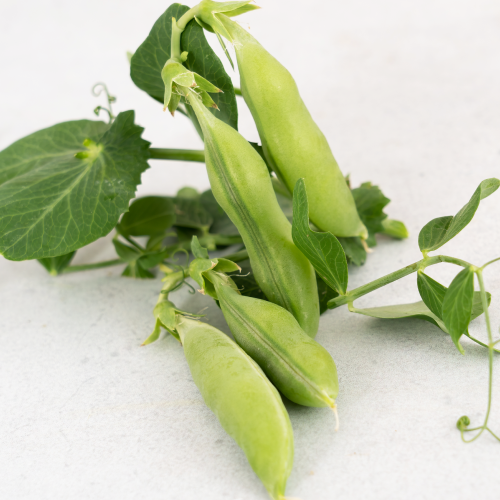Peas
For more details on growing peas, explore our Peas Care Guide here!
Latin name: Pisum sativum
🌱 Days to Sprout: 7-14
😋 Ready for Full Dose of plant food with true leaves or roots .5-inch long
✂️ Thin to: 1 plant per yCube
🍅 Days to Maturity: 60-80
💡 Light Zone: Medium
📏 Plant Size: < 2 ft
💚 Care Level: Advanced
Origin
While popular in Europe, peas likely originated in the eastern Mediterranean. In the mid-19th century, Austrian monk Gregor Mendel’s experiments with peas led to discoveries that laid the foundation for modern genetic science. This particular heirloom variety was developed in 1902.
Qualities
This updated variety is known for its bountiful harvests, more compact size of less than 2 feet, crunchier and sweeter fruit, and lack of brown leaves as the plant matures. The pods are about 3 inches long with minimal strings. Peas are part of the legume family, along with plants such as chickpeas, lentils, and beans, and as such they have a high level of fiber and more protein than most plants. They are rich in antioxidants, vitamin C, carotenoids, and flavonols. They also contain heart-healthy minerals such as potassium, magnesium, and calcium.
Use
Peas are a common and versatile ingredient in many cuisines. Enjoy these crunchy-sweet pea pods whole (no need to shell them!) as a fresh snack or lightly sautéed.
Care & Harvest
🐝 Pollination: Peas need help with pollination. When flowers appear, gently shake the entire plant, or gently disturb the inside of blossoms with your finger or a small brush.
🫶 Support: Peas climb with 1-inch tendrils that wrap around anything small they can reach. We recommend using our Trellis and Plant Belts to direct the vine up your Gardyn’s columns and support the plant's fruit.
✂️ Pruning: Check the roots monthly and trim any that are brown or extending past the yPod.
🔎 Plant Health: Aphids and thrips are a common pest, but you can use our prevention and treatment tricks to keep pests at bay! A harmless growth called neoplasm may also develop on pods - learn more in our Peas Care Guide!
🫘 Harvest: Once the pods begin to look plump, harvest them every few days to stimulate new fruit development. Cut the pods from the vine and either eat immediately or refrigerate them and use within the week. Removing the string-like thread that runs down the back of pods is optional. If you notice the pea pods’ shells become tough, simply remove the shell and enjoy the sweet peas inside.
Harvest to Plate Recipe
Quick Asian Peas
Recipe Source: Eat Something Vegan
Ingredients
8 oz. peas, string removed and trimmed (if needed)
½ tbsp. grapeseed oil or other neutral-tasting oil
1 garlic clove
1 tsp. minced ginger
1 tbsp. soy sauce
1 tsp. toasted sesame oil
½ tbsp. toasted sesame seeds
Instructions
In a large skillet, sauté the garlic and ginger in oil for 1 minute over medium heat.
Add Peas and soy sauce and cook, stirring occasionally, for about 5-7 minutes.
Turn off the heat, add the sesame oil, and stir.
Sprinkle with sesame seeds and serve.
Our Plant Health & Nutrition Team thoroughly tests each variety we offer to bring you the most flavorful and high-quality plants. We regularly rotate our plant portfolio, so please note, availability varies.

